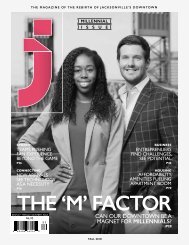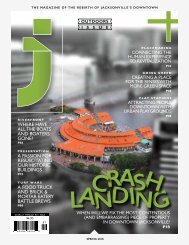HS_Aug16_ForOnline_HiRes
You also want an ePaper? Increase the reach of your titles
YUMPU automatically turns print PDFs into web optimized ePapers that Google loves.
Daily Thrive<br />
WORKPLACE WELLNESS<br />
By Jon Vredenburg, MBA, RD, CDE, CSSD, LD/N<br />
Lack of time is typically the number one excuse people will claim for not getting enough physical activity.<br />
The lunch hour provides a great opportunity to maintain<br />
some level of fitness amidst our busy lives. Although emerging<br />
from a mid-day workout dripping with sweat may be<br />
great for maximizing the heart rate, it can be bad for business.<br />
Thankfully, it is still possible to stay active at lunch, without<br />
needing to take the rest of the day off for cleaning up.<br />
“If people want to work out during their lunch hour but<br />
don’t want to get hot and sweaty, I recommend staying<br />
indoors,” says Ellen Crook, a personal trainer with the San Jose<br />
Country Club. “The most important thing is to get up out of<br />
your desk and get moving.”<br />
Crook suggests walking may be the most practical way to stay<br />
active, but knows that it is not always the most reliable way to<br />
avoid the outdoor heat. Seeking areas around the office or nearby<br />
complexes and shopping centers can offer an air-conditioned<br />
venue to get moving.<br />
“Walking laps can help you increase your daily step count,”<br />
adds Crook. “A good daily goal to shoot for is 10,000 steps per<br />
day.” For the average person, this would equate to about 5 miles<br />
per day, and although walking speeds vary achieving a 15-minute<br />
mile can be a reasonable expectation. Walking after a meal<br />
has also been known to help with digestion and can be helpful<br />
for managing blood sugar spikes in those with diabetes.<br />
Crook also advocates working on flexibility with low-impact<br />
exercises such as yoga during the lunch hour. Yoga offers an<br />
array of benefits, including stress management which bodes well<br />
for the working professional. “Yoga is a great exercise. It is slow<br />
paced and typically won’t make you sweat too much,” Crook<br />
says. There are many types of yoga but the Bikram and hot yoga<br />
classes are the primary types that feature heated studios, and<br />
therefore can be counterproductive to avoiding sweat. If yoga<br />
classes are not available, Pilates can be another option.<br />
Sweating is part of the recipe for calorie burning, but adding<br />
a shower to an already tight lunch schedule makes it even<br />
tougher to get away from that desk. “The relationship between<br />
exercise intensity and perspiration is relatively linear. The harder<br />
you exercise, the more you sweat,” Crook says. “The muscles<br />
will heat up from exercise, and your body sweats so it can cool<br />
down from the sweat evaporating.”<br />
Lunchtime fitness should be part of a comprehensive wellness<br />
approach. Although you may not be able to engage in the level<br />
of training that can generate a big calorie burn, it is not a reason<br />
to avoid moving. “Every little bit of exercise throughout the day<br />
can add up to a great workout,” she says. After all, getting moving<br />
during lunch often fights the one thing that really adds to our<br />
waistline — more time spent eating.<br />
10 First Coast Health Source August 2016

















